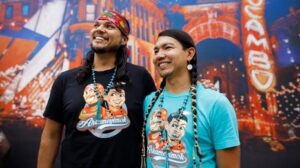By Hendrix O.
While many of us are learning more about LGBTQ history from the past hundred years or so, it’s important to know that we’ve been around for far longer than that. Historically, there are many cultures around the globe that have acknowledged and honored people that exist on a fluid spectrum of gender and sexuality. In Turtle Island* alone, there are many indigenous communities that have more than two genders and gender roles.

So, why do some people still believe this experience is so new? This can be a result of a number of things, such as the increase of LGBTQ mainstream media representation in the past couple decades. We also could have been taught a version of US history that doesn’t give us the full story (y’know, like the version where North American history begins with Columbus sailing the ocean blue). Turns out, LGBTQIA2s+ existence goes way back! The English term “Two-Spirit” was created to acknowledge that fact.
For those of us who are new to the term, Two-Spirit (often shortened to “2S”) is an English term for Indigenous people who have both feminine and masculine spirits. Depending on the tribe, a person’s Two-Spirit identity can describe how they express themself, what work they do in the community, and/or what role they may have in traditional ceremonies. The term was created at the 3rd Annual Native American Gay and Lesbian Gathering in 1990, in Winnipeg, Manitoba, Canada.
Why is this English term for a Native-specific identity important? It’s used as a tool to understand Two-Spirit experience in both Native and Non-Native communities. The term gives Native folks like myself, who aren’t fluent in their traditional language, a way to describe yourself that celebrates both our culture and our queerness. It also gives us an umbrella term to use when educating non-Native people about the long history of expansive, inclusive identities.
While some Native people identify as LGBTQIA+, this does not automatically mean that they also identify as Two-Spirit. This is because “being Two-Spirit” can mean different things from tribe to tribe, and those meanings may or may not overlap with a Native person’s LGBTQIA+ identity. This is similar to how not every queer person identifies as trans, and not every trans person identifies as queer.
The existence of Two-Spirit people is proof that Indigenous people and our lifeways have not gone extinct, despite the efforts of colonization. The Assimilation Era (also known as the Boarding School Era) was an attempt to erase indigenous cultures completely. In the late 1800s, European settlers began forcing their way of life on Native communities in an attempt to “civilize” us. This included things like making us speak English, wear Western clothing, and practice Christianity. Native youth were given new names, new rules on how to wear their hair, and harsh punishments if they refused to conform to white, western culture.
Our past continues to affect all generations of our community. Since our ancestors and elders were forced to assimilate for their own safety, there were less and less chances to remember and pass on our traditions. Many of us forgot our language, our practices, or even our original names. Some tribes shifted from Matriarchal to Patriarchal to reflect western culture. Along this line, many of us forgot about or deprioritized our Two-Spirit relatives.
This is why learning our history and reclaiming all aspects of our culture is so meaningful. We can’t have true Native liberation if we don’t have Two-Spirit, Queer, and Trans liberation, so we must fight for all of it. Doing so honors those who came before us, respects those of us in the present, and liberates those who come after us.
*Turtle Island: Turtle Island is a name for Earth or North America, used by some Indigenous Peoples in Canada and the United States, as well as by some Indigenous Activists. The name is based on a common North American Indigenous creation story.
Debrief Questions:
- Why is TQ2S+ history important?
- What are ways we can honor our TQ2S+ ancestors?
- How can we be accomplices to Native LGBTQIA+ and Two-Spirit people?
- What do we want to pass on to the next generations of TQ2S+ youth?
